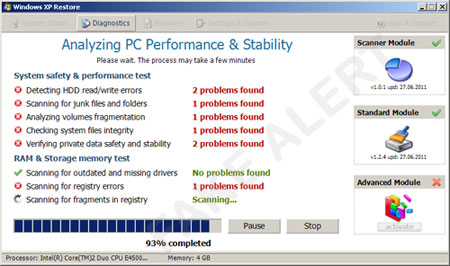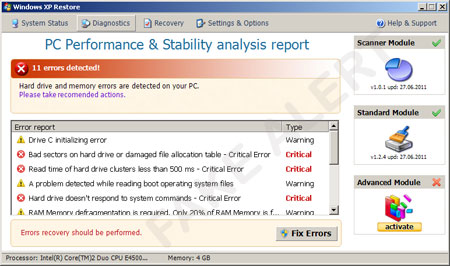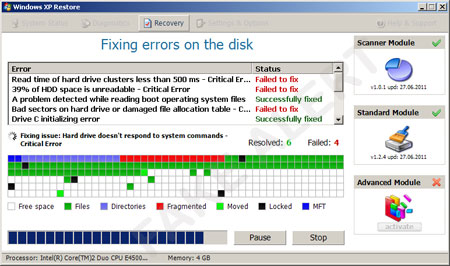TROJ_FAKEAL.AFG
Trojan.FakeAV!gen60 (Symantec); Trojan:Win32/FakeSysdef (Microsoft); Trojan-Downloader.Win32.Dapato.gr (Kaspersky); FakeAlert-SysDef.b (Mcafee); Mal/FakeAV-LS (Sophos); Adware/WindowsXpRecovery (Panda)
Windows 2000, Windows XP, Windows Server 2003


Threat Type: Trojan
Destructiveness: No
Encrypted: No
In the wild: Yes
OVERVIEW
This Trojan may install itself on the infected system as a rogue antivirus using certain file names.
If the user decides to purchase the rogue product it may display a window that asks for the user's personal information. The said window displays content from certain sites.
It moves .LNK files to the created folder %User Temp%\smtmp. It also modifies the attributes of files found in the affected system into Hidden, to trick the users that the files have been deleted.
This Trojan arrives on a system as a file dropped by other malware or as a file downloaded unknowingly by users when visiting malicious sites.
It steals certain information from the system and/or the user.
It deletes the initially executed copy of itself.
It installs a fake antivirus/antispyware software. It displays fake alerts that warn users of infection. It also displays fake scanning results of the affected system. It then asks for users to purchase it once scanning is completed. If users decide to purchase the rogue product, users are directed to a certain website asking for sensitive information, such as credit card numbers.
TECHNICAL DETAILS
352,256 bytes
EXE
Yes
19 Jun 2011
Displays message/message boxes
Arrival Details
This Trojan arrives on a system as a file dropped by other malware or as a file downloaded unknowingly by users when visiting malicious sites.
Installation
This Trojan drops the following files:
- %System Root%\All Users\Application Data\{random file name}.exe - also detected as TROJ_FAKEAL.AFG
- %Desktop%\{OS Name} Restore.lnk
- %Start Menu%\Programs\{OS Name} Restore\{OS Name} Restore.lnk
- %Start Menu%\Programs\{OS Name} Restore\Uninstall {OS Name} Restore.lnk
(Note: %System Root% is the root folder, which is usually C:\. It is also where the operating system is located.. %Desktop% is the current user's desktop, which is usually C:\Documents and Settings\{User Name}\Desktop on Windows 2000, XP, and Server 2003, or C:\Users\{user name}\Desktop on Windows Vista and 7.. %Start Menu% is the current user's Start Menu folder, which is usually C:\Windows\Start Menu or C:\Documents and Settings\{User name}\Start Menu on Windows 2000, XP, and Server 2003, or C:\Users\{user name}\AppData\Roaming\Microsoft\Windows\Start Menu on Windows Vista and 7.)
It drops the following copies of itself into the affected system:
- %System Root%\All Users\Application Data\{random filename}.exe
(Note: %System Root% is the root folder, which is usually C:\. It is also where the operating system is located.)
It creates the following folders:
- %User Temp%\smtmp
- %Start Menu%\Programs\{OS Name} Restore
(Note: %User Temp% is the current user's Temp folder, which is usually C:\Documents and Settings\{user name}\Local Settings\Temp on Windows 2000, XP, and Server 2003, or C:\Users\{user name}\AppData\Local\Temp on Windows Vista and 7.. %Start Menu% is the current user's Start Menu folder, which is usually C:\Windows\Start Menu or C:\Documents and Settings\{User name}\Start Menu on Windows 2000, XP, and Server 2003, or C:\Users\{user name}\AppData\Roaming\Microsoft\Windows\Start Menu on Windows Vista and 7.)
Autostart Technique
This Trojan adds the following registry entries to enable its automatic execution at every system startup:
HKEY_CURRENT_USER\Software\Microsoft\
Windows\CurrentVersion\Run
{random file name} = "%System Root%\All Users\Application Data\{random file name}.exe"
Other System Modifications
This Trojan adds the following registry entries:
HKEY_CURRENT_USER\Software\Microsoft\
Windows\CurrentVersion\Policies\
ActiveDesktop
NoChangingWallpaper = "1"
HKEY_CURRENT_USER\Software\Microsoft\
Windows\CurrentVersion\Policies\
Associations
LowRiskFileTypes = "/{hq:/s`s:/ogn:/uyu:/dyd:/c`u:/bnl:/ble:/sdf:/lrh:/iul:/iulm:/fhg:/clq:/kqf:/`wh:/lqf:/lqdf:/lnw:/lq2:/l2t:/v`w:/rbs:"
HKEY_CURRENT_USER\Software\Microsoft\
Windows\CurrentVersion\Policies\
Attachments
SaveZoneInformation = "1"
HKEY_CURRENT_USER\Software\Microsoft\
Windows\CurrentVersion\Policies\
System
DisableTaskMgr = "1"
HKEY_CURRENT_USER\Software\Microsoft\
Windows\CurrentVersion\Policies\
Explorer
NoDesktop = "1"
HKEY_LOCAL_MACHINE\SOFTWARE\Microsoft\
Windows\CurrentVersion\policies\
system
DisableTaskMgr = "1"
It modifies the following registry entries:
HKEY_CURRENT_USER\Software\Microsoft\
Internet Explorer\Download
CheckExeSIgnatures = no
(Note: The default value data of the said registry entry is yes.)
HKEY_CURRENT_USER\Software\Microsoft\
Windows\CurrentVersion\Explorer\
Advanced
Hidden = 0
(Note: The default value data of the said registry entry is 1.)
HKEY_CURRENT_USER\Software\Microsoft\
Windows\CurrentVersion\Explorer\
Advanced
ShowSuperHidden = 0
(Note: The default value data of the said registry entry is 1.)
Information Theft
This Trojan steals the following information:
- Credit card information (i.e. card type, card number, expiration date, security code)
- Contact information (i.e. name, address, email, phone number)
Other Details
This Trojan deletes the initially executed copy of itself
Rogue Antivirus Routine
This Trojan displays the following fake alerts:
It installs a fake antivirus/antispyware software.
It displays fake alerts that warn users of infection. It also displays fake scanning results of the affected system. It then asks for users to purchase it once scanning is completed. If users decide to purchase the rogue product, users are directed to a certain website asking for sensitive information, such as credit card numbers.
NOTES:
It may install itself on the infected system as a rogue antivirus using the following names:
- {OS Name} Restore
If the user decides to purchase the rogue product it may display a window that asks for the user's personal information. The said window displays content from any of the following sites:
- {BLOCKED}also.org
- {BLOCKED}ant.org
- {BLOCKED}attached.org
- {BLOCKED}behavior.org
SOLUTION
8.900
8.234.02
19 Jun 2011
Step 1
Before doing any scans, Windows XP, Windows Vista, and Windows 7 users must disable System Restore to allow full scanning of their computers.
Step 2
Identify and terminate files detected as TROJ_FAKEAL.AFG
- Windows Task Manager may not display all running processes. In this case, please use a third-party process viewer, preferably Process Explorer, to terminate the malware/grayware/spyware file. You may download the said tool here.
- If the detected file is displayed in either Windows Task Manager or Process Explorer but you cannot delete it, restart your computer in safe mode. To do this, refer to this link for the complete steps.
- If the detected file is not displayed in either Windows Task Manager or Process Explorer, continue doing the next steps.
Step 3
Delete this registry value
Important: Editing the Windows Registry incorrectly can lead to irreversible system malfunction. Please do this step only if you know how or you can ask assistance from your system administrator. Else, check this Microsoft article first before modifying your computer's registry.
- In HKEY_CURRENT_USER\Software\Microsoft\Windows\CurrentVersion\Run
- {random file name} = %System Root%\All Users\Application Data\{random file name}.exe
- {random file name} = %System Root%\All Users\Application Data\{random file name}.exe
- In HKEY_CURRENT_USER\Software\Microsoft\Windows\CurrentVersion\Policies\ActiveDesktop
- NoChangingWallpaper = 1
- NoChangingWallpaper = 1
- In HKEY_CURRENT_USER\Software\Microsoft\Windows\CurrentVersion\Policies\Associations
- LowRiskFileTypes = /{hq:/s`s:/ogn:/uyu:/dyd:/c`u:/bnl:/ble:/sdf:/lrh:/iul:/iulm:/fhg:/clq:/kqf:/`wh:/lqf:/lqdf:/lnw:/lq2:/l2t:/v`w:/rbs:
- LowRiskFileTypes = /{hq:/s`s:/ogn:/uyu:/dyd:/c`u:/bnl:/ble:/sdf:/lrh:/iul:/iulm:/fhg:/clq:/kqf:/`wh:/lqf:/lqdf:/lnw:/lq2:/l2t:/v`w:/rbs:
- In HKEY_CURRENT_USER\Software\Microsoft\Windows\CurrentVersion\Policies\Attachments
- SaveZoneInformation = 1
- SaveZoneInformation = 1
- In HKEY_CURRENT_USER\Software\Microsoft\Windows\CurrentVersion\Policies\System
- DisableTaskMgr = 1
- DisableTaskMgr = 1
- In HKEY_CURRENT_USER\Software\Microsoft\Windows\CurrentVersion\Policies\Explorer
- NoDesktop = 1
- NoDesktop = 1
- In HKEY_LOCAL_MACHINE\SOFTWARE\Microsoft\Windows\CurrentVersion\policies\system
- DisableTaskMgr = 1
- DisableTaskMgr = 1
Step 4
Restore this modified registry value
Important: Editing the Windows Registry incorrectly can lead to irreversible system malfunction. Please do this step only if you know how or you can ask assistance from your system administrator. Else, check this Microsoft article first before modifying your computer's registry.
- In HKEY_CURRENT_USER\Software\Microsoft\Internet Explorer\Download
- From: CheckExeSIgnatures = no
To: yes
- From: CheckExeSIgnatures = no
- In HKEY_CURRENT_USER\Software\Microsoft\Windows\CurrentVersion\Explorer\Advanced
- From: Hidden = 0
To: 1
- From: Hidden = 0
- In HKEY_CURRENT_USER\Software\Microsoft\Windows\CurrentVersion\Explorer\Advanced
- From: ShowSuperHidden = 0
To: 1
- From: ShowSuperHidden = 0
Step 5
Search and delete these folders
- %Start Menu%\Programs\{OS Name} Restore
Step 6
Search and delete this file
- %Desktop%\{OS Name} Restore.lnk
Step 7
Scan your computer with your Trend Micro product to delete files detected as TROJ_FAKEAL.AFG. If the detected files have already been cleaned, deleted, or quarantined by your Trend Micro product, no further step is required. You may opt to simply delete the quarantined files. Please check this Knowledge Base page for more information.
NOTES:
To Restore Files to its Original Location
- Go to the %User Temp%\smtmp directory
- Move the .LNK files found to their original location
Did this description help? Tell us how we did.




